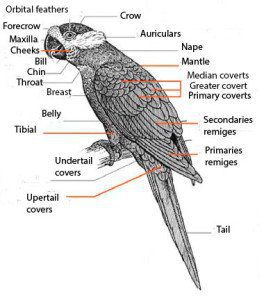Content
|
|---|
Description
40 to 42 cm. long.
The Black-lored Parrot (Tanygnathus gramineus) It has a green head with a black line that goes from the top of the beak to the eyes.; steeped in turquoise blue Crown. The upper parts of green grass.
The medium-sized wing coverts, green; flight feather, green, a little darker, with blackish margins to the vane inner. Supracaudales coverts yellowish-green. The more underparts, more yellowish green, especially in the lower part of the cheeks and upper part of the chest. Upper, the Green tail with yellow tips; undertail, the Brown tail olive warm.
Billed red; iris yellow ; greyish legs.
Female with the grey brown peak, not red.
Immature undescribed.
- Sound of the Black-lored Parrot.
Habitat:
Information is received for the first time of the Black-lored Parrot Thanks to ornithologist side Hendrik Cornelis Sieber (1890-1949) in 1930.
Very little of this species is known. Is distributed in mountain forests above 600-700 meters and also, according to sources, in the lowlands, hills and coastal areas. It is partially nocturnal, although sightings of birds perched on treetops during the day, They show that, similar to the Azure-rumped parrot, they can also be active during the day.
Migration is relatively weak and there are only a few reports of parrots flying to high altitudes during the day and descending at night., Judging from their voices.
Reproduction:
There is no data.
Food:
Possibly fruits, berries, seeds and nuts
Distribution:
Endemic to Buru, Indonesian.
Bird predominantly occupies the central part, High Island, where according to sources, There are settlements in Gunung Tagalago, WA Temun and Kunturun, at elevations of 700-1100 m, also in the lowlands of the South in Fäkal, EHU and Leksula. There was a sighting of these parrots near Kayeli Bay on the eastern shores of Buru. Most recent observations made outside North (Waflia) and (Wamlana) Northwest Coast.
The voice of the Black-lored Parrot is heard frequently in Kunturun, mostly 1-7 hours after the sunset, where the locals call the bird “The ol' blue cockatoo“, which means Blue-headed Parrot. But, was caught during the day with slingshots in fruit trees, suggesting that his activity is not purely night.
Conservation:
• Current category of the Red List of the UICN: Vulnerable
• Population trend: Decreasing
The population is estimated at 2,500-9,999 mature individuals based on an assessment of the known records, descriptions of the abundance and range size. This estimate is equivalent to 3,500-15,000 specimens.
There are no data on trends for this species and has not been seen in the wild since 1995. Their habitat continues to decline slowly and were recorded in domestic trade in the year 2001. So, the population of the species is suspected of have been declining.
Conservation Actions Proposed:
– Conduct surveys, mostly using their vocalizations at night, mainly in the mountain areas.
– Investigate their ecological requirements and movements in order to develop appropriate conservation strategy.
– Identify the most suitable area for the conservation of this and other endangered species in Buru, and promote its establishment as protected areas.
"Black-lored Parrot" in captivity:
Unknown outside the island of Buru
Alternative names:
– Black-lored Parrot, Black lored Parrot, Blacklored Parrot, Buru Parrot (ingles).
– Perruche de Buru, Perruche à calotte bleue (French).
– Burupapagei, Buru Papagei (German).
– Tanygnathus gramineus (Portuguese).
– Loro de Buru (español).
scientific classification:
– Order: Psittaciformes
– Family: Psittaculidae
– Genus: Tanygnathus
– Scientific name: Tanygnathus gramineus
– Citation: (Gmelin, JF, 1788)
– Protonimo: Psittacus gramineus
Images "Black-lored Parrot"
————————————————————————————————
“Black-lored Parrot” (Tanygnathus gramineus)
Sources:
– Avibase
– Parrots of the World – Forshaw Joseph M
– Parrots A Guide to the Parrots of the World – Tony Juniper & Mike Parr
– Birdlife
– Wikipedia
– Photos:
(1) – Parrots A Guide to the Parrots of the World – Tony Juniper & Mike Parr
– Sounds: Frank Lambert (Xeno-canto)

